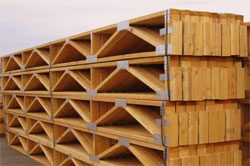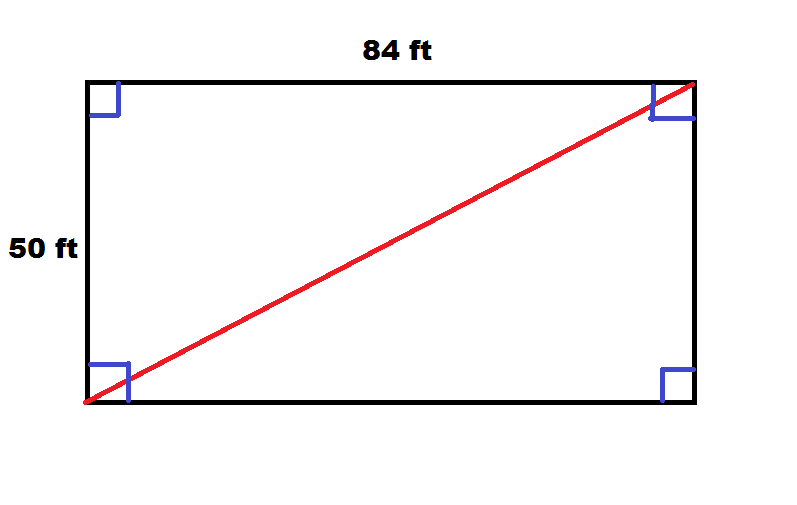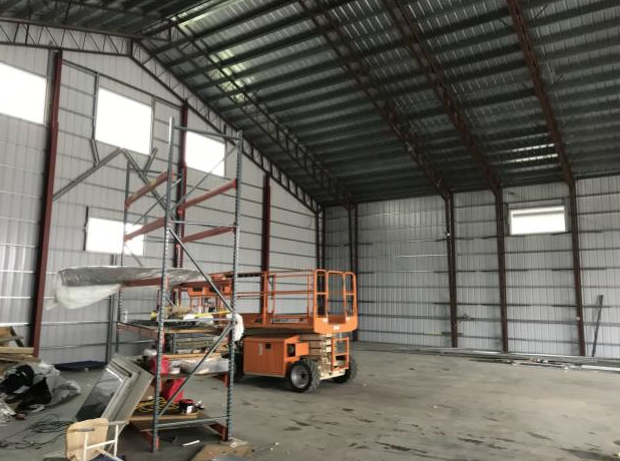When I was first in the metal connector plated wood truss industry back in 1977, my employers – Dutch Andres and Tom Vincent at Spokane Truss, had just invested in a machine which would fabricate what would be called a 4×2 floor truss.
These trusses revolutionized the way floors could be constructed – freeing up areas below them from the need for load bearing walls and columns in all of the most inconvenient places!
Rick Ochs is new to the inside team at Hansen Pole Buildings, and earlier this week, he posed a question:
“Hey Mike,
No rush… I have been viewing tutorials from WTCA (Wood Truss Council of America) on trusses and structural building components. I was wondering why we don’t spec floor trusses instead of the traditional 2×10 with hangers. Cost I presume.
Thanks!”
Floor trusses will be significantly more expensive.
Let’s say you have a 2×10 at .6285m (current price at The Home Depot®) so a 12′ would be $12.57.
(“m” happens to be lumber people’s secret code for 1000 board feet)
If they were even 16″ o.c., you are talking 0.79 per square foot for the cost of joists.
Floor trusses are going to run around $4.40 per lineal foot, spaced 2′ on center, this makes the cost per square foot for the joists at $2.20.
For a floor span of over 24′ trusses are certainly the way to go.
To which Rick responded:
“I’m thinking it would take a little more math on the builder/customer part to compare against labor cost savings of setting floor truss vs time required to set hangers, cut and nail joists.”
Personally, I have metal connector plated wood floor trusses in two of my personal buildings – in one case spanning 30 feet and the other 48 (yes a 48 foot clearspan floor).
Here are some of the benefits of using wood floor trusses:
- Larger sheathing attachment, with 2×3 or (usually) 2×4 nailing surface,
- Spacing up to 24” o.c. maximizes efficiency, decreasing installation time.
- Each unique truss is engineered to proper codes and loading.
- Speeds up mechanical installation (think heat ducts) with the open webbing thus saving dollars.
- Span longer distances than conventional lumber or I-joists.
- Special bearing, cantilever, and balcony details are easily built in.
- Less pilferage, it is unlikely a 20’ truss is going to walk off the jobsite.
- Faster jobsite build times, saving jobsite labor, construction loan interest, vandalism, and environmental damage.
Wood floor trusses can also be designed to limit the deflection and vibration, read more here:
https://www.hansenpolebuildings.com/2015/12/wood-floors-deflection-and-vibration/
In the global scope of life, having a wood truss supported floor is a fairly economical upgrade, which is certainly something worth investigating.











Considering a cabin garage combination building.
My land is located close to Park Rapids, Mn.
Hi Dan,
I have passed along your inquiry to one of our Building designers.
Thank you,
PBG
I wouild like to get a price for 18′ high 3″x1/2 with x 32′ long wood trusses if the works for a live load please call me at 808-868-6836
We are not a truss fabricator, you might check in with the Pro Desk at your nearby The Home Depot there in Hawaii for a price.
I need 12 30 ft x 24 inches high 2×4 width . Could you give me a price ?
Thank you for your interest. We are neither fabricators or resellers of floor trusses. We would suggest you contact the ProDesk at your nearby The Home Depot.
how much would a 32′ wood truss cost
It will depend upon the loading, spacing and depth. With current lumber and labor costs probably around $6 per lineal foot. For an exact price quote, we would recommend you contact the ProDesk at your local The Home Depot.
I had no idea that floor trusses can be designed to limit deflection and vibration. I would like this for my house because I hate it when something shakes my house. Floor trusses wouldn’t let my neighbor’s loud music do that as much anymore.
It was mentioned that in using wood floor trusses, it eliminates the need to put columns in the load bearing walls beneath the flooring. We are building a house right now. I wonder if they will be putting this in our flooring.
If you do not know, then chances are they are not 🙁
If I understand correctly, floor trusses can be engineered to support interior load-bearing walls above with a clear span below? That’s a game changer! I’m designing my new home now. Thanks.
They can be – however it does take some special design work to be able to do so. In most instances, your roof trusses will span from exterior wall to exterior wall so there is no reason to have load bearing on your building’s interior.
I have a metal building designed around a 3 bay concept totaling bays of
20’x50’ the entire building is 3000 sq ft.
The (3) three bays share all common walls interior and exterior walls.I am not
Planing on finishing the attic space but I just might do that sooner than later.
I need quick ordering and derlivrry services!
I can go with the 20ft span across each bay or span the length of each pay 50 spans.
The entire building has been predetermined to have all outer walls are all 2”x 6” loaded walls.
Please provide me a phone number of manufacture os such floor trusses
My direct number is 619-735-0070
Whitney Texas 76692
Tcthetford@yahoo.com
Quickest route would be to reach out to the ProDesk at your nearby The Home Depot
We have 2×4 floor trusses 24” tall 19.4” oc spanning 31 feet under the main level of our house. Can we get tile floors put in as well as granite countertops in our kitchen? The kitchen is kind of to the center of the floor.
Some of my answer will depend upon design dead loads of your floor trusses. Typically you have a BCDL (bottom chord dead load) of 5 psf and a TCDL (top chord dead load) of anywhere from 5 to 10 psf. Your BCDL is eaten up by your sheetrock and weight of truss. Your TCDL must account for weight of subfloor (most often being 3/4″ plywood at 1.9 psf or OSB at 2.4 psf). This doesn’t leave much margin for tile at 4 to 6 psf (with some products being even heavier). It also does not account for weight of other substrates or mortar. Chances are a floor tile system will be above capacity of your floor system. For granite countertops 3/4″ thick weighs 13 psf, 1-1/4″ 18-20 psf. In areas supporting granite countertops, I would normally recommend doubling floor trusses in these areas, or cutting space in half.